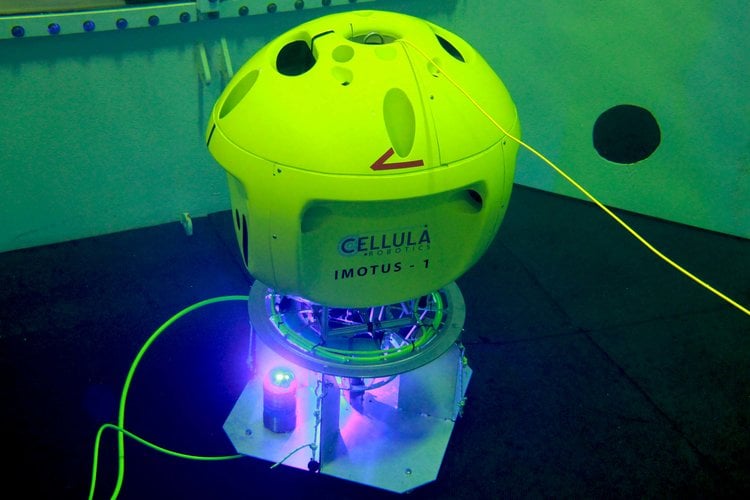What's New In Robotics This Week - 01.19.18

Posted on Jan 19, 2018 7:03 AM. 14 min read time
-Manufacturing & Cobot Roundup
-Machines Beat Humans @ Stanford Reading Test
-Stunning Drone Rescue
-Baby Bot, Microbots & Stingrays
...and much more!
Manufacturing & Cobot Roundup
SecondHands --the EU-funded project tasked with designing a cobot that can "offer help to a maintenance technician in a pro-active manner"-- revealed its impressive-looking prototype, the 'ARMAR-6.'
Set for testing in Ocado's highly-automated warehouses, the cobot will initially be used as technician's assistants --effectively functioning as cobots designed to help humans fix robots.
Via IEEE Spectrum:
In the context of a maintenance task, for example, the robot should be able to proactively recognize what’s going on, and understand what exactly the human worker is trying to do. Then, it can anticipate critical points at which the human might need assistance, and offer help without being explicitly directed. Rather than waiting for the human to say, “Hey, can you hand me that hammer,” the robot will recognize when the hammer is necessary, and offer it before the human asks.
The Engineer reports that "the robot will learn through observation and will augment the humans’ capabilities by completing tasks that require a level of precision or physical strength that are not available to human workers."
Researchers at Politecnico Milan demonstrated some of their recent work on human-robot interaction...
Asian Robotics Review released the first installment of a fascinating two-part series on cobots:
The revolution that ushered in the world of cobots is entirely unprecedented in the seventy-year history of robotics. No similar machine has come so far so fast, and has so penetrated the marketplace like this lightweight, highly maneuverable robot arm that has so quickly become the everyman tool on a global scale for any size manufacturer…and lately, for most any warehouse as well.
UK-based robot maker Tharsus has identified cobots as a technology to watch in its 2018 Trends in Robotics report. Via Manufacturing Global:
The manufacturer states that there is to be an increase in the use of collaborative robots (co-bots), due to advancements and lower prices of artificial intelligence (AI) and motion-sensing technologies.
Because of such advances, co-bots are becoming extensively smarter, making more efficient and capable of working with humans.
A new video shows cobots being used for assembly and kitting in the aerospace industry...
CA Technologies has announced plans to work on cobots with researchers from Tampere University of Technology, Finland and Tieto, a Finnish IT software and services company. ZDNet reports:
CA CTO Otto Berkes said the company is looking for the project to help it develop the proper models, algorithms and security for human-robot collaboration.
According to CA, the first phase of the cobotics effort is to conclude at the end of 2018. CA's Strategic Research group aims to work with academia, governments, and industry groups.
eWEEK has more on CA's move into the collaborative robotics space.
FANUC America showcased its robots being used for automated spot welding and handling automotive parts...
Astounding growth" at Universal Robots has seen the company sell 20,000 of its cobots, says Robotics & Automation News:
Universal Robots will have a lot of competition going forward, but Helmut Schmid, the company’s general manager with responsibility for a number of countries in Europe, says he is “happy” that new competitors are entering the market.
Winsconsin Plastics Inc shared video of one of Universal Robots' UR5 cobots at work...
Brain-machine interface (BMI) startup BrainCo has revealed a BMI-integrated robotic arm; Japanese robot makers are seeing "strong Chinese tailwinds in 2018," according to Nikkei Asian Review; and the industrial robot market --worth about USD31.15 billion in 2016-- is expected to reach USD71.75 billion in 2023 at an average growth rate of 9.65%, says a new report.
A team from the Robotics Group at the University of Patras, Greece is working on a system to help industrial robots distinguish between different types of contact between humans and robots...
Elsewhere, "The Robots Are Coming" says Supply Chain Management Review; Canadian Metalworking shared tips for introducing your first robot; cobots are seeing growing penetration in the blowmolding sector, says Plastics Today; and WIRED reported on a new type of job that's emerging due to the growing popularity of robots --call center operators for bots, or "robot babysitters."
R-V Industries showcased one of its robotic welding cells in operation...
Finally, Ulrich Spiesshofer, CEO of robot maker ABB, sat down with The Engineer for an interview about collaboration, innovation, and overcoming fears and misunderstandings about the consequences of automation:
"We’re coming from an industrial environment where automation helps to replace muscle, into a new environment where we bring together actuation, control, sensing, digitalisation and AI to make sure the expertise that’s captured in the brains of our people and control systems gets lifted out and aggregated so that we can really augment human potential by the use of AI.”
Machines Beat Humans @ Stanford Reading Test
A pair of artificial neural networks developed separately by Microsoft and Alibaba have outscored humans on the "grueling" Stanford Question Answering Dataset (SQuAD) --a test designed to test humans' reading and comprehension capabilities.
Via Discovery:
The algorithm developed by Alibaba’s Institute of Data Science Technologies, SLQA+, notched a score of 82.44 on the test, which was just a hair better than the 82.304 scored by humans. Alibaba claims it is the first time a machine has performed better than flesh-and-blood in the ExactMatch metric of the Stanford test. Microsoft Research Asia also outdid humans, and its R-NET+ scored 82.650.
CNN has more.
Stunning Drone Rescue
In what's being described as a world first, two teenage swimmers in difficulty off the Australian coast were rescued by a drone that delivered a rescue pod directly to their location.
Amazingly, the Little Ripper UAV was being tested by local lifeguards when they were informed of the swimmers in distress.
The BBC reports:
John Barilaro, the state's deputy premier, praised the rescue as historic. "Never before has a drone fitted with a flotation device been used to rescue swimmers like this," he said.
Lifeguard supervisor Jai Sheridan was piloting the device when the alarm was raised. He described the experience as "unreal".
The NSW government announced in December 2017 that it has invested USD340,000 in a fleet of drones for sharkspotting, security, public announcements, and rescue operations. The Sydney Morning Herald has more.
Elsewhere, Indian Railways announced this week that it plans to use NETRAv2 drones to monitor rescue operations and control traffic; robots are helping to end world hunger; AirVuz released its 2017 Drone Video Awards Nominees (voting closes Jan 21st); China announced plans to send a robot sub to the site of a sunken ship; and Cellula Robotics revealed its hovering, autonomous underwater vehicle...
 Caption: "During a week of testing at a local pool facility, Imotus-1 navigated using proprietary SLAM (Simultaneous Localization and Mapping) algorithms and was shown to hold station, waypoint track, maneuver around obstacles and dock to an underwater charging station. Inspection tools including point cloud map generation, high definition video, an ultrasonic thickness gauge and a light cleaning brush were also demonstrated." (Via Unmanned Systems Technology.)
Caption: "During a week of testing at a local pool facility, Imotus-1 navigated using proprietary SLAM (Simultaneous Localization and Mapping) algorithms and was shown to hold station, waypoint track, maneuver around obstacles and dock to an underwater charging station. Inspection tools including point cloud map generation, high definition video, an ultrasonic thickness gauge and a light cleaning brush were also demonstrated." (Via Unmanned Systems Technology.)
Baby Bot, Microbots & Stingrays
Researchers at Purdue University have developed a baby bot to test how much dirt, pollen, skin cells and bacteria are launched into the air — and then inhaled — by crawling infants.
Via Live Science:
They took a crawling baby doll and transformed it into a silvery, legless contraption that drags itself forward by paddling its arms, and whose trunk terminated in an array of wires and cables. As the robot scooted over sections of debris-rich carpets — which were taken from actual homes — the study authors collected and analyzed the particle clouds that rose up around it.
A fully 3D-printed whisker sensor made of polyurethane, graphene, and copper tape can detect underwater vortexes with very high sensitivity, according to a new study. "The simple design, mechanical reliability, and low-cost fabrication method contribute to the important commercial implications of this versatile new sensor," PhysOrg reports.
Meanwhile, a team led by UCLA bioengineering professor Ali Khademhosseini has created a tissue-based soft robot that mimics the biomechanics of a stingray.

The 10-millimeter long robot is made up of four layers: tissue composed of live heart cells, two distinct types of specialized biomaterials for structural support, and flexible electrodes. Imitating nature, the robotic stingray is even able to "flap" its fins when the electrodes contract the heart cells on the biomaterial scaffold.
The stingray-inspired bot could one day be used to perform microsurgery inside the human body.
Researchers at Harvard's Wyss Institute for Biologically Inspired Engineering and the John A. Paulson School of Engineering and Applied Sciences have developed a milimeter-scale delta robot, dubbed 'milliDelta.' The device could be used to perform microsurgery or micromanufacturing processes.
The 15 mm x 15 mm x 20 mm robot weighs just 430 milligrams, but it has a payload capacity of 1.3 grams. It can move around its 7 cubic millimeter workspace with a precision of about 5 micrometers. What’s really impressive, though, is the speed: It can reach velocities of 0.45 m/s, and accelerations of 215 m/s2, meaning that it can follow repeating patterns at a frequency of up to 75 Hz.
Like a semi-autonomous microbot on a timer, I'll be back next week with more robotics news. Until then, please enjoy these videos and links!
Humanoid robots overcoming uncanny valley (South China Morning Post)
CES International 2018 highlights (Newsday)
This robot will fold your laundry in 2 to 4 minutes (CNBC)
Robot Rampage at CES 2018 (Electronic Design)
CES 2018 recap: Out of the dark ages (Robohub)
A Robotic Implant Could Treat Congenital Disorders in Babies (Futurism)
Can Robots Tighten the Bolts on a Rickety Caregiver Sector? (Scientific American)
Robot Helpers Are Coming to the Space Station (Air&Space)
What This Ping-Pong Robot Tells Us About the Next Phase of Human-Robot Interaction (Entrepreneur)
Uber close to scrapping human backups in robot cars (IOL)



Leave a comment